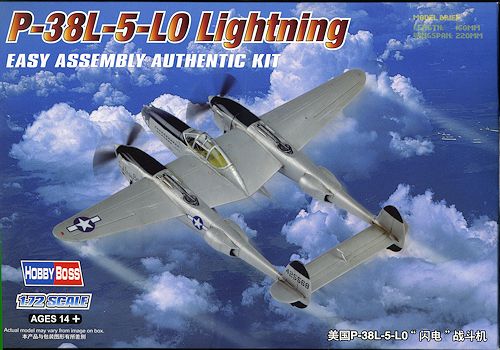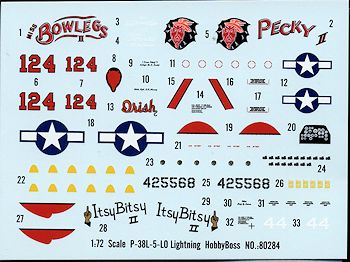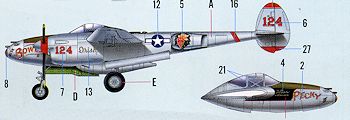
Hobby Boss 1/72 P-38L-5-LO Lightning
| KIT #: | 80284 |
| PRICE: | $15.99 SRP |
| DECALS: | Two options |
| REVIEWER: | Scott Van Aken |
| NOTES: | Easy Assemble Authentic Kit |

| HISTORY |
The Lockheed P-38 Lightning was a World War II American fighter aircraft built by Lockheed. Developed to a United States Army Air Corps requirement, the P-38 had distinctive twin booms and a single, central nacelle containing the cockpit and armament. Named "fork-tailed devil" (der Gabelschwanz-Teufel) by the Luftwaffe and "two planes, one pilot" (2飛行機、1パイロット Ni hikōki, ippairotto) by the Japanese, the P-38 was used in a number of roles, including dive bombing, level bombing, ground-attack, night fighting, photo-reconnaissance missions, and extensively as a long-range escort fighter when equipped with drop tanks under its wings.
The P-38 was used most successfully in the Pacific Theater of Operations and the China-Burma-India Theater of Operations as the mount of America's top aces, Richard Bong (40 victories) and Thomas McGuire (38 victories). In the South West Pacific theater, the P-38 was the primary long-range fighter of United States Army Air Forces until the appearance of large numbers of P-51D Mustangs toward the end of the war.
The P-38 was unusually quiet for a fighter, the exhaust muffled by the turbo-superchargers. It was extremely forgiving, and could be mishandled in many ways, but the rate of roll in the early versions was too slow for it to excel as a dogfighter. The P-38 was the only American fighter aircraft in production throughout American involvement in the war, from Pearl Harbor to Victory over Japan Day.
| THE KIT |
 Squadron
Products was kind enough to send me two of the latest batch of easy build kits
from Hobby Boss and this was the second one. After the sub-type
misidentification found with the Thunderbolt, I first looked up the serial of
one of the two options (the other had no visible serial) and verified that it
was a -5. The kit has the anti-compressibility brakes on the underside of the
wing and the fairings for the four fuel pumps that are major clues to the
subtype.
Squadron
Products was kind enough to send me two of the latest batch of easy build kits
from Hobby Boss and this was the second one. After the sub-type
misidentification found with the Thunderbolt, I first looked up the serial of
one of the two options (the other had no visible serial) and verified that it
was a -5. The kit has the anti-compressibility brakes on the underside of the
wing and the fairings for the four fuel pumps that are major clues to the
subtype.
With that out of the way, it was time to look things over. No worries about boom alignment on this one as the only major fuselage bits not in one mold are the fins, lower fuselage and lower forward boom area. This one has a separate interior but is still pretty Spartan when it comes to details. There is a two piece control wheel assembly, a seat and an instrument panel to install long with rudder pedals, so perhaps this is one of their 'high tech' snaps! The nose gear well is the underside of the cockpit tub.
Landing gear both fore and aft have separate wheels, oleo scissors and retraction struts. The main gear doors, often an issue on P-38s, are a single construct along with the main gear wells. Boom intakes are separate as are the fin sections. Turbocharger bits are also separate and the kit provides a one piece canopy. For things under wings you have a pair of drop tanks. The nose is separate as are the forward engine nacelles. It is here that one will load in the 6 grams of weight to keep it on its main gear. This is actually a goodly amount of weight for a kit of this size, but there is room.
 Markings are
for two unpainted metal planes. One is the box art plane of then-Major George
Lavin Jr and his 'Itsy Bitsy II' with the 54th FS/343rd FG at the end of the
war. Nose, upper and lower fin tips, ant
Markings are
for two unpainted metal planes. One is the box art plane of then-Major George
Lavin Jr and his 'Itsy Bitsy II' with the 54th FS/343rd FG at the end of the
war. Nose, upper and lower fin tips, ant i-glare
panel and upper forward engine nacelles are black and will need to be painted.
The other is 'Bowlegs/Pecky II' of the 431FS/475 FG, also at the end of the war.
The red markings on the fin are decals, but not the aft part of the propeller
spinners or the black areas below the anti-glare panel. Instructions are well
drawn and the decals look to be quite good. Like the previous kit, this one was
also not enclosed in a plastic tray, but that was really not needed as any
fragile parts are wrapped in foam wrap.
i-glare
panel and upper forward engine nacelles are black and will need to be painted.
The other is 'Bowlegs/Pecky II' of the 431FS/475 FG, also at the end of the war.
The red markings on the fin are decals, but not the aft part of the propeller
spinners or the black areas below the anti-glare panel. Instructions are well
drawn and the decals look to be quite good. Like the previous kit, this one was
also not enclosed in a plastic tray, but that was really not needed as any
fragile parts are wrapped in foam wrap.
| CONCLUSIONS |
This is another well done kit and thanks to the near one piece fuselage, I can see this one being built quite a bit. Booms have always been a bit of an issue for me. It will not replace the super Academy kit, but it is well worth the money. I am still not exactly sure to whom these kits are marketed. The easy assembly leans to youngsters, but the small parts and somewhat complex paint schemes suggests more accomplished modelers. Still, it is well worth the funds and those who want to add a little to it (like a seat harness) should be quite pleased with the results.
| REFERENCES |
http://en.wikipedia.org/wiki/P-47_Thunderbolt
February 2013
Thanks to Squadron Products for the review kit. You can find this kit at your favorite hobby shop or on-line retailer.
If you would like your product reviewed fairly and fairly quickly, please contact the editor or see other details in the Note to Contributors.